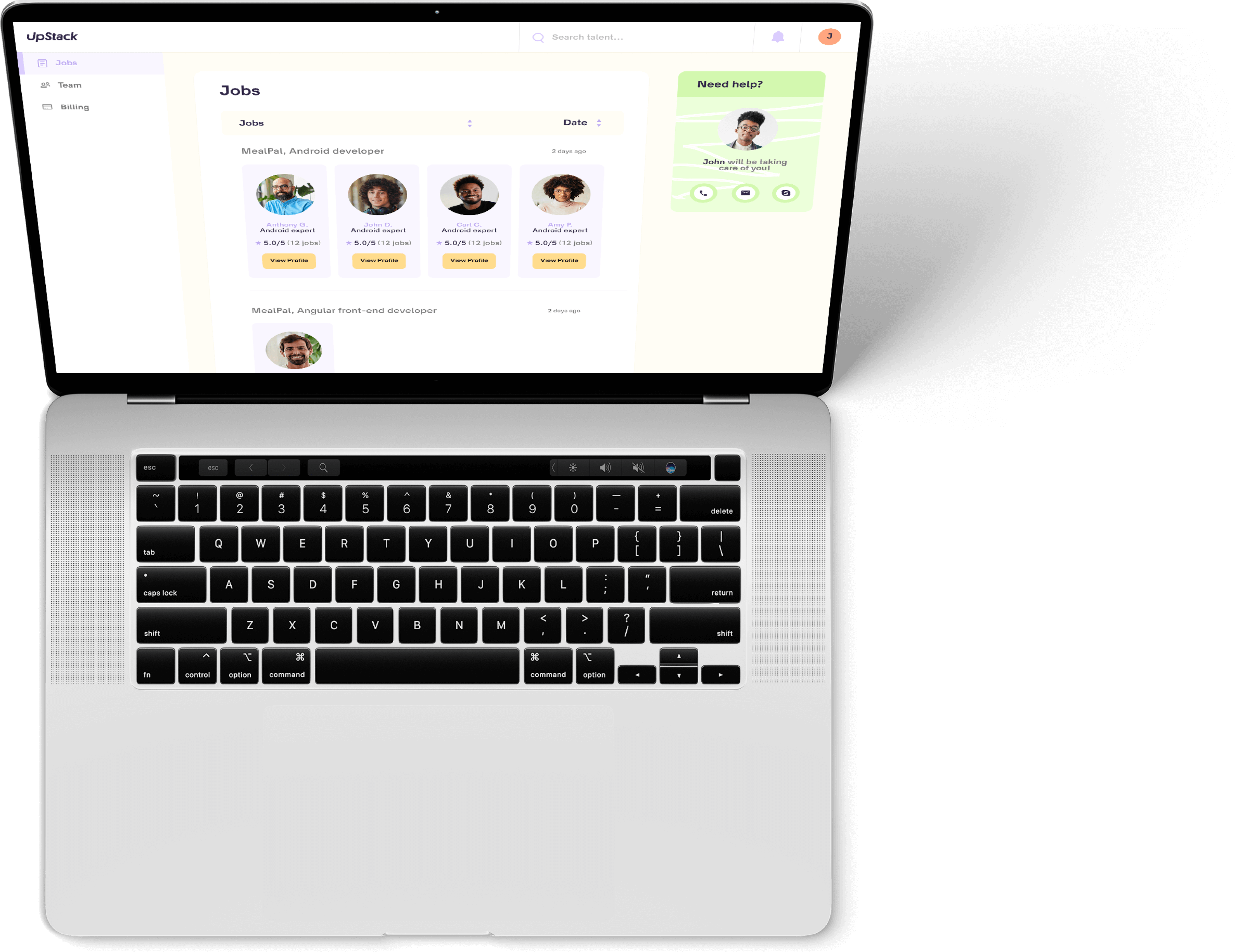


Hire Spark Developers Remotely {Devs Ready!}
Stella B.
Available
Spark Developer
-
Experienced Spark engineer with seamless project implementation
-
Loves guacamole & hates spoilers

-
Marcus T.
Available
Spark Engineer
-
Stacked portfolio of beautiful, functional websites
-
Known for his epic charcuterie & cheese boards

-
David M.
Available
Mobile Developer
-
Mobile engineering guru with a knack for translating stakeholder needs
-
Would rather be diving Palau's Blue Corner

-
Top Spark Developers with UpStack
Hire Spark Developers with UpStack
When it comes to tackling big data projects, there is no better choice than a Spark developer. Spark is a powerful open-source tool for analytics and data processing, and having a skilled developer on your team can make the difference between success and failure. Hiring the right person for the job can be a troubling task, as it requires a deep understanding of the technology, the task at hand, and the company’s needs. This section will provide guidelines on how to hire a Spark developer and what to look for in order to make the best decision. By understanding the roles and responsibilities of a Spark developer, you can ensure that you have the right person for the job and create a successful big data project.
What is a Spark Developer?
A Spark developer is someone who writes and maintains code that runs on the Spark platform. The Spark platform is used to run data analytics applications. A Spark developer’s responsibilities may include designing and implementing data pipelines and orchestrating data processing pipelines. Some of the most common tasks expected of a Spark developer are: A Spark developer should be able to write, test, document, and debug the code, as well as troubleshoot issues that may arise.
What are the roles and responsibilities of a Spark Developer?
The responsibilities of a Spark developer can vary depending on their experience, role, and the project specifics. In general, Spark developers are responsible for designing, implementing, and testing big data applications that run on a distributed processing engine like Apache Spark. Most of the time, a Spark programmer will work with data engineers to create data pipelines and transform raw data into useful and actionable insights. Spark developers write code that is deployed on Apache Spark and Hadoop clusters.
How to assess a Spark Developer’s skills?
There are a few key skills required by Spark developers. These include technical skills, soft skills, and project management skills. Let’s take a closer look at each one: - Technical skills: A Spark developer must have an in-depth understanding of the technology. This includes Apache Spark architecture, distributed data processing, data modelling, and machine learning applications. - Soft skills: Spark developers must also possess soft skills, particularly communication and team collaboration. This is because Spark development is a collaborative process that involves collaboration between data engineers and data scientists. A Spark programmer should also be able to communicate effectively with both technical and non-technical stakeholders, which requires clear and thorough communication.
What to look for in a Spark Programmer?
You can determine if a programmer is a good fit for a Spark project by reviewing their resume, past projects, and interviewing them. Let’s take a look at what each of these factors reveals about a candidate: - Resume: The resume should provide insight into a candidate’s experience with Spark. Ideally, the candidate should have experience with Apache Spark, Spark Streaming, and Spark SQL. - Projects: When reviewing past projects, look for references to the use of Spark. A good indicator that the candidate has worked with Spark is if they are working with a distributed data processing platform. - Interview: During the interview, you should be able to determine how well the candidate understands the project and how they would approach the solution. It’s also important to evaluate the candidate’s communication and collaboration skills.
What type of contract should you use to hire a Spark Developer?
There are two types of contracts that you can use to hire a Spark programmer: an employment contract or a contractor agreement. - Employment contract: An employment contract is a long-term agreement where the employee is considered a full-time member of the team. A benefits package may be included in this type of contract. - Contractor agreement: A contract for services, also known as a contractor agreement, is a short-term agreement that does not include benefits. This type of agreement is most often used to hire freelancers.
What to consider in the job descriptions?
When creating job descriptions for Spark developers, there are a few key points to consider: - Location: Some companies have a preference for hiring developers from a specific location. It is important to note this in the job description. - Experience: Be sure to specify how much experience is required for the position. This will help you eliminate candidates who are not qualified for the job. - Skills: What specific skills are needed to fill the position? You can use these skill requirements to eliminate candidates that are unqualified. - Salary range: When it comes to salary, there are many factors that go into determining the level of compensation for the role. A few things to consider when determining the salary range are the level of experience, skills, and location of the candidate.
How to onboard and manage a Spark Programmer?
In order to onboard and manage a Spark programmer, you need to create a culture of collaboration. This means creating an open environment where employees feel comfortable sharing ideas and feedback with each other. A culture of collaboration is important because it will allow engineers and developers to share their expertise with each other, which will save time and enable successful projects. Hiring the right person can help your business succeed by improving the efficiency of data processing and creating valuable insights.
They trust Our Spark Developers
Why hire a Spark developer with UpStack
![Spark Developer and Programmer]()
Top Spark talent pre-vetted for a perfect fit.
Our 8-point assessment evaluation ensures that every senior Spark developer you interview exceeds expectations across technical, cultural, and language criteria.
![Spark Programmers Computer Icon]()
Hire reliable, passionate Spark developers.
From late-night sprints to jumping on a last-minute face-to-face, we ensure that your recruits are down to get the job done right.
![Spark Programmers High Five Icon]()
Risk-free 14-day trial.
Confidently onboard candidates with our no-questions-asked trial period. We'll walk you through the contract-to-hire process if and when you're ready to make it permanent with your new Spark engineer.
![Spark Computer Programmer Icon]()
Our Client Success Experts provide white-glove service.
Stay laser-focused on your business goals while our team of experts curates potential candidates and manages seamless programmer onboarding.
![Spark Developer Writing Notes Icon]()
Build your optimal team confidently, quickly.
UpStack handles everything including background and reference checks, legal issues, and more. Our platform streamlines billing, timesheets, and payment all in one easy-to-access place.
Schedule a call with a Client Success Expert to get starting hiring a Spark developer.
Start hiring Start hiring Start hiring
Hire from the Best.
Working with our Client Success Experts, we'll help you build the remote team of your dreams with top Spark talent from around the world.
Pre-vetted, reliable Spark developers are standing by.





Hiring Spark Developers | FAQs
How much does it cost to hire a Spark developer?
UpStack has a simple billing model where each Spark developer has a standard hourly rate averaging between $65-$75 per hour. Rates are based on skills, knowledge, and experience, and our developers are available mainly for full-time engagement (40 hours per week) and the occasional part-time opportunity (20 hours per week).
What is the process to find a Spark developer?
You'll connect with an UpStack Client Success Manager to determine your immediate needs. Our team uses a combination of AI and personal assessment to short-list candidates that match your job requirements. From there, you interview, select, and onboard the perfect developer, all within days of your initial call.
How does UpStack find its Spark developers?
UpStack's talent recruitment team connects with software developers around the globe every day. Each Spark programmer is vetted for technical, communication, and other soft skills necessary for a developer to successfully work with your team. Once vetted, the candidates are accepted into the UpStack developer community.
How is UpStack different from an agency or recruiter?
UpStack's community of available, pre-vetted engineering talent means minimizing roadblocks to scaling your team effectively, efficiently, and immediately. Our Client Success Experts work with you and your UpStack developer to ensure a smooth and seamless engagement.
Can I hire UpStack Spark developers directly?
Yes, you can hire UpStack Spark developers at any time, and with the same assurance of smoothly on boarding talent risk-free. First, we'd create a job opening on our portal. Then, we'd vet, interview, and match developers that meet your needs. If you're satisfied at the end of the 14-day trial period, at any time you can directly hire them.
Common FAQs about Spark?
What is Spark?
Apache Spark is an open-source, distributed computing system that is designed for fast processing of large-scale data sets. It is a popular choice for data processing and analytics in the big data ecosystem, and is used by a wide range of organizations to process and analyze data from a variety of sources. Spark is written in Scala, a programming language that runs on the Java Virtual Machine (JVM), and provides a unified programming model for data processing and analytics tasks. It includes a wide range of features and libraries that enable developers to perform a variety of data processing and analytics tasks, such as data ingestion, transformation, and enrichment; machine learning; and real-time data processing.
Some key features of Spark include:
- In-memory data processing: Spark stores data in memory, which allows it to process data much faster than disk-based systems.
- Resilient Distributed Datasets (RDDs): Spark uses RDDs to distribute data across a cluster of computers, which makes it easy to scale out data processing and analytics tasks.
- SQL support: Spark includes a SQL engine that allows developers to write queries in SQL to process and analyze data.
- Machine learning libraries: Spark includes a number of libraries for machine learning tasks, such as classification, regression, clustering, and collaborative filtering.
Spark is a powerful tool for data processing and analytics, and is widely used in the big data ecosystem to handle large-scale data sets and perform complex data processing and analytics tasks.
Is Spark free?
Yes, Apache Spark is an open-source software project that is freely available for anyone to use. It is released under the Apache License, which is a permissive free software license that allows users to use, modify, and distribute the software for any purpose, including commercial use. Spark is developed and maintained by the Apache Spark community, which is made up of volunteers who contribute to the project through code contributions, documentation, testing, and other forms of support. The project is funded by donations and sponsorships, and is supported by a wide range of organizations and individuals.
Is Spark a programming language?
No, Apache Spark is not a programming language. It is an open-source, distributed computing system that is designed to process and analyze large data sets quickly and efficiently. Spark is written in the Scala programming language, but it provides APIs in other languages such as Python, Java, and R, so that developers can use it with their preferred language. Spark is often used for data processing, machine learning, and other types of data analytics tasks. It is widely used in the field of big data and is known for its ability to handle very large data sets and perform computations in parallel across a distributed cluster of computers.
What is faster Spark or SQL?
It is difficult to compare the performance of Spark and SQL directly, as they are designed for different purposes and can be used in different contexts.
SQL (Structured Query Language) is a language used to work with relational databases, and it is optimized for querying and manipulating data stored in tables. SQL is typically used to extract, transform, and load (ETL) data from a variety of sources, and it is well suited for working with structured data.
On the other hand, Apache Spark is a distributed computing system that is designed to process and analyze large data sets quickly and efficiently. It is often used for data processing, machine learning, and other types of data analytics tasks. Spark can process data in a variety of formats, including structured and semi-structured data, and it is able to perform computations in parallel across a distributed cluster of computers.
In general, Spark is often faster than SQL for certain types of data processing tasks, particularly those that involve large data sets or require complex computations. However, the specific performance characteristics will depend on the specific workload and the configuration of the systems being used.
It is worth noting that SQL can be used with Spark through the Spark SQL module, which allows developers to use SQL queries to manipulate data stored in Spark data structures. This can make it easier to use SQL and Spark together to perform various data processing tasks.
Can I use Spark for ETL?
Yes, Apache Spark can be used for Extract, Transform, Load (ETL) tasks. ETL refers to the process of extracting data from various sources, transforming it into a format that is suitable for analysis, and loading it into a target system such as a data warehouse. Spark is well-suited for ETL tasks because it can handle large volumes of data and perform computations in parallel across a distributed cluster of computers.
Spark provides a number of built-in functions and libraries that can be used to extract data from various sources, transform it into the desired format, and load it into a target system. For example, Spark can read data from a variety of sources such as text files, CSV files, JSON files, and databases, and it can write data to a variety of formats such as Parquet, Avro, and ORC. In addition to the built-in functions and libraries, Spark also provides a number of third-party libraries that can be used for ETL tasks. For example, the Spark-Redshift library can be used to load data from Amazon Redshift into Spark, and the Spark-Kafka library can be used to stream data from Kafka into Spark.















